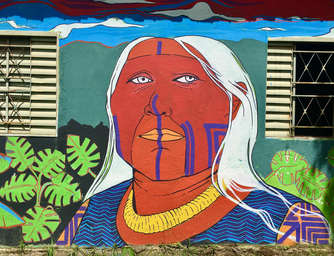The latest demographic census by IBGE (Brazilian Geography Institute) indicated that currently, only 0.43% of the Brazilian population is composed of indigenous peoples. Despite the small proportion, the influence of native culture is much bigger than anyone could ever imagine, as many traditional elements of these people are present in our daily lives.
In indigenous culture, myths not only fulfill their function of explaining natural factors of human beings, but are also responsible for preserving indigenous memory. Unlike European cultures, native people did not have the habit of recording their stories in writing, so orality is a striking characteristic of native folklore. The problem began with the colonization process of Brazil, in which the strong oppression of native communities interfered in the transmission of cultural myths, which ended up being lost.
The scientific studies about Brazilian folklore started to be produced in the XIX century, driven by the concern to shape a popular imaginary typically Brazilian. However, there was a strong tendency to hide these indigenous and africans components present in the folkloric stories of the nation. As an attempt to rescue the origin of our national culture, rediscover 5 folklores that have indigenous origins, which were erased throughout the history of the country.
- Saci-pererê
-
Derived from the Tupi-Guarani “çaa ey pererey“, which means the act of jumping, Saci-Pererê is described in stories as a one-legged black boy who likes to play tricks on people. In reality, studies indicate that the myth of Saci began with indigenous peoples in southern Brazil, a region with strong European and African influences. The character was responsible for mischief and tragedies that occurred in rural environments, with a much more violent tone.
The story of the Saci was softened due to the urgency of finding a character that could become a national symbol. The most prominent agent in this reimagining of the Saci-Pererê story was Monteiro Lobato, who softened the character’s more rebellious and violent traits so it could be used for the children’s book “O Saci”(1921). The truth is that the folklore of the Saci-Pererê was built around numerous retellings, with his indigenous origins increasingly being erased.
- Vitória-Régia
-
The story of the Vitória-Régia has different versions, given that the native population has a rich cultural diversity among themselves. The most widely reproduced version is that of an indigenous woman named Naiá, who is in love with Jaci, the moon, and wishes to be with him. However, Jaci is known for turning young women into stars. One night, Naiá visits Jaci next to the river, and then he transforms her into a “water star”, the great amazonian flower, so that she reflects the moonlight.
This myth, traditionally better known in the northern region of the country, has a strong indigenous influence in its composition, notable for highlighting the strength of the relationship between nature, the forest, and human beings. In addition, the Amazonian flower has great importance in indigenous culture, since its root has high nutritional value and is also used for pigment extraction.
- Guaraná
-
The narrative tells the story of an indigenous boy who was killed by his own uncles when he touched a chestnut tree. His mother collected his body and planted the right eye of the young man on black land. It grew into a guarana plant, as if it were a seed.
This myth originates from the Sateré Mawé indigenous community, which inhabits the region of the middle Amazon River. It was through the guarana fruit that these people found a symbol of self-image. The transformation from human to food is not entirely seen as a fatality, but rather as a way for life to continue in alterity.
- Boitatá
-
The legend of Boitatá tells that a fire serpent ignites anyone who unnecessarily burns nature, which happens frequently in rural environments.
This myth originates from a natural phenomenon called “fogo-fátuo,” which is a chemical reaction formed by gases derived from the decomposition of organic matter. It moves quickly through the air, generating spiral figures. In the darkness of night, the “fogo-fátuo” resembles the movement of a serpent.
Despite being a story of indigenous descent, one of the earliest recorded versions of this myth is attributed to José de Anchieta, around 1560. In his work, it is possible to see that Anchieta incorporated indigenous mythology into the description of this narrative, which highlights the erasure of the real origins of Brazilian folklore.
- Curupira
-
The Curupira is a mythological figure that has different representations, varying from one culture to another. There are records of this folkloric being not only in Brazil, but also in other countries in South America, appearing with different names.
For example, in Guarani mythology, the character is called Kurupi and is described as a small being with flaming hair and feet turned backwards. His purpose is to protect the fauna and flora against the predatory actions of hunters and loggers.
Indigenous Peoples’ Day is celebrated every April 19th in Brazil, in order to promote the diversity of native peoples in the country. It becomes increasingly apparent day after day how necessary it has become to reclaim this culture that has been made invisible. It is unacceptable that a country like Brazil still treats its own history with such disregard.
——————————
The article above was edited by Clarissa Palácio.
Liked this type of content? Check Her Campus Cásper Líbero homepage for more!


